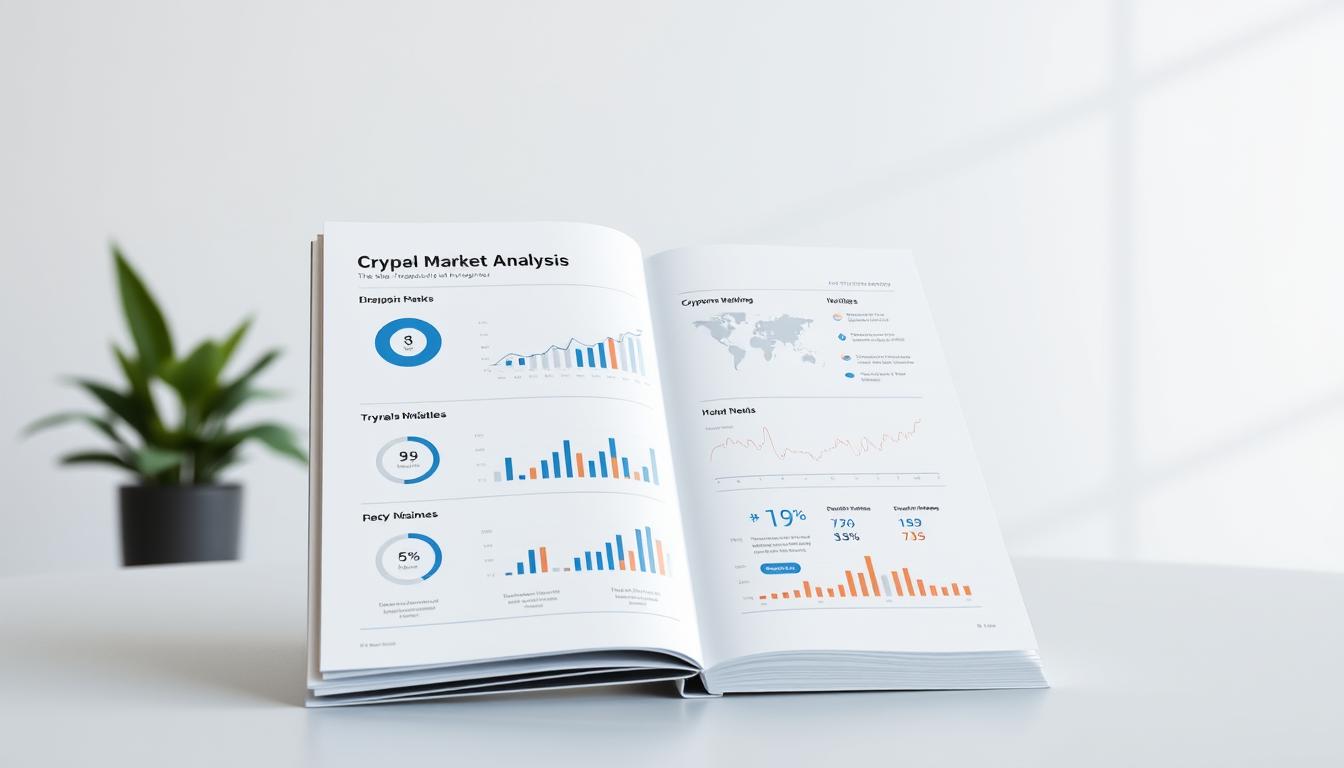Now Reading: Cryptocurrency Market Analysis for Beginners Step by Step
- 01
Cryptocurrency Market Analysis for Beginners Step by Step
Cryptocurrency Market Analysis for Beginners Step by Step

Diving into the world of cryptocurrency market analysis can seem overwhelming for newcomers. This comprehensive beginners guide breaks down the complex landscape of digital asset trading into manageable steps. Cryptocurrency market analysis requires strategic thinking and a structured approach that helps investors navigate volatile markets.
Understanding the fundamentals of cryptocurrency trading empowers investors to make informed decisions. Whether you’re a novice or looking to refine your investment strategies, this step-by-step analysis will provide critical insights into evaluating digital assets effectively.
From decoding market trends to implementing risk management techniques, our guide transforms complicated crypto concepts into practical knowledge. We’ll explore essential tools, analytical methods, and key indicators that drive successful cryptocurrency investments.
Key Takeaways
- Learn systematic cryptocurrency market analysis techniques
- Understand core principles of digital asset evaluation
- Develop skills to interpret market indicators
- Recognize potential investment opportunities
- Build a structured approach to crypto trading
Understanding the Fundamentals of Cryptocurrency Markets
Diving into the world of crypto market fundamentals requires a solid grasp of key concepts and terminology. Cryptocurrency has transformed the financial landscape, offering investors and enthusiasts a new way to understand digital assets and market dynamics.
Navigating the cryptocurrency ecosystem begins with understanding its core terminology. Investors need to familiarize themselves with critical cryptocurrency terminology that forms the backbone of digital asset trading.
Basic Cryptocurrency Concepts
- Blockchain: Decentralized digital ledger technology
- Wallet: Digital storage for cryptocurrency assets
- Tokens: Digital representations of value or utility
- Mining: Process of validating transactions on blockchain networks
Market Capitalization Decoded
Market cap represents the total value of a cryptocurrency calculated by multiplying the current price by total circulating coins. Understanding market cap helps investors assess the relative size and potential of different crypto assets.
Types of Cryptocurrencies
- Payment Cryptocurrencies: Bitcoin, Litecoin
- Smart Contract Platforms: Ethereum, Cardano
- Privacy Coins: Monero, Zcash
- Stablecoins: Tether, USD Coin
Exploring these types of crypto provides insight into the diverse ecosystem of digital assets, each serving unique purposes within the broader cryptocurrency market.
Essential Tools for Cryptocurrency Market Analysis
Navigating the complex world of cryptocurrency markets requires powerful crypto analysis tools and market analysis software. Investors and traders need reliable cryptocurrency data platforms to make informed decisions in this volatile landscape.
Modern crypto enthusiasts have access to a range of sophisticated analytical resources. These tools help break down complex market data into understandable insights.
- Real-time price tracking platforms
- Advanced charting software
- Sentiment analysis tools
- Portfolio management applications
Key market analysis software offers several critical features for cryptocurrency investors:
- Comprehensive price monitoring
- Historical data visualization
- Technical indicator analysis
- Trading volume tracking
Popular cryptocurrency data platforms like CoinMarketCap, TradingView, and CoinGecko provide comprehensive market intelligence. These platforms enable users to analyze market trends, compare different cryptocurrencies, and develop strategic investment approaches.
Professional traders typically utilize multi-layered crypto analysis tools that integrate various data sources. These sophisticated platforms help investors understand market dynamics, predict potential movements, and manage risk effectively.
Reading and Interpreting Cryptocurrency Charts
Crypto chart analysis is a critical skill for understanding cryptocurrency market movements. Traders and investors rely on visual representations of price data to make informed decisions. Learning to read charts effectively can help you navigate the complex world of digital assets.
Charts provide a graphical representation of price changes, helping investors track market trends and potential opportunities. The three primary elements of crypto chart analysis include candlestick patterns, support and resistance levels, and trading volume.
Candlestick Patterns and Their Meanings
Candlestick patterns are powerful tools in crypto chart analysis. These visual representations show price movements within specific time frames. Key patterns include:
- Bullish Engulfing: Indicates potential price reversal upward
- Hammer: Suggests potential trend reversal after a downtrend
- Doji: Represents market indecision
Support and Resistance Levels
Support and resistance levels are crucial concepts in technical analysis. These price points represent key psychological barriers in cryptocurrency trading.
| Level Type | Description | Trading Significance |
|---|---|---|
| Support | Lower price boundary | Potential buying opportunity |
| Resistance | Upper price boundary | Potential selling point |
Volume Analysis Basics
Trading volume provides critical insights into market momentum. High volume often confirms price trends, while low volume might indicate weak market interest. Traders use volume to validate potential price movements and assess market sentiment.
Mastering these chart analysis techniques can help cryptocurrency investors make more strategic trading decisions and understand market dynamics more effectively.
Key Market Indicators for Crypto Trading

Navigating the cryptocurrency market requires understanding critical market indicators that help traders make informed decisions. Crypto market indicators provide valuable insights into market trends, potential trading signals, and overall market sentiment.
Traders use various technical and fundamental indicators to analyze cryptocurrency price movements and predict potential market directions. These tools help investors identify entry and exit points with greater precision.
- Relative Strength Index (RSI)
- Moving Average Convergence Divergence (MACD)
- Bollinger Bands
- Volume Indicators
- On-Balance Volume (OBV)
Market trend analysis involves examining multiple indicators simultaneously to generate comprehensive trading signals. Professional traders typically combine different indicators to validate their market predictions.
| Indicator | Purpose | Signal Type |
|---|---|---|
| RSI | Measure Price Momentum | Overbought/Oversold |
| MACD | Trend Direction | Bullish/Bearish Crossovers |
| Volume | Trading Strength | Market Participation |
Beginners should practice reading these crypto market indicators carefully. Developing a nuanced understanding takes time and consistent study of market patterns. Start by tracking indicators on historical charts before applying them to live trading scenarios.
Effective market trend analysis requires continuous learning and adaptation. Each cryptocurrency market has unique characteristics, making indicator interpretation both an art and a science.
Fundamental Analysis in Cryptocurrency Markets
Crypto fundamental analysis is a critical skill for investors seeking to understand the true potential of digital assets. This approach goes beyond price charts to evaluate the intrinsic value of cryptocurrency projects by examining their core strengths and market positioning.
Successful project evaluation requires a comprehensive examination of multiple key factors that determine a cryptocurrency’s long-term viability and growth potential.
Project Evaluation Methods
Investors should focus on several critical aspects when conducting crypto fundamental analysis:
- Technological innovation and blockchain infrastructure
- Unique value proposition
- Scalability and potential for real-world implementation
- Economic model and token utility
Team Assessment and Technology Review
The strength of a cryptocurrency project heavily relies on its development team and technological framework. Team assessment involves investigating:
- Founders’ background and expertise
- Developer experience
- Track record of previous projects
- Community engagement and transparency
Market Adoption and Use Cases
Understanding market adoption helps investors gauge a project’s potential for real-world impact. Key indicators include:
| Adoption Metric | Significance |
|---|---|
| Partnership Networks | Indicates industry recognition and potential growth |
| Active User Base | Demonstrates practical utility and community interest |
| Transaction Volume | Reflects real-world usage and economic activity |
By systematically analyzing these crucial elements, investors can develop a robust approach to cryptocurrency project evaluation and make more informed investment decisions.
Technical Analysis Strategies for Beginners

Diving into crypto technical analysis can seem overwhelming for new traders. Beginners should start with fundamental price action analysis techniques that help decode market movements and trading patterns. Understanding these strategies builds a strong foundation for making informed cryptocurrency investment decisions.
Effective beginner trading strategies typically focus on several key elements:
- Identifying trend directions
- Recognizing chart patterns
- Analyzing price momentum
- Understanding market sentiment
When learning cryptocurrency investment strategies, traders should prioritize learning basic chart reading skills. Price action analysis helps investors understand market psychology and potential future price movements.
| Strategy | Key Focus | Difficulty Level |
|---|---|---|
| Moving Averages | Trend Identification | Beginner |
| Support/Resistance Levels | Price Boundaries | Beginner |
| Relative Strength Index | Momentum Measurement | Intermediate |
Practice remains crucial in developing strong crypto technical analysis skills. New traders should start with paper trading and gradually build confidence through consistent learning and observation of market dynamics.
Cryptocurrency Market Analysis for Beginners Step by Step
Navigating the complex world of cryptocurrency markets requires a strategic approach to step-by-step crypto analysis. Successful traders and investors develop a structured methodology that transforms raw market data into actionable insights.
Mastering market research methods is crucial for anyone looking to understand the dynamic cryptocurrency landscape. Beginners need a clear framework that breaks down the analysis process into manageable steps.
Market Research Methodology
Effective data analysis in cryptocurrency markets involves several key components:
- Identify reliable data sources
- Collect comprehensive market information
- Validate data accuracy
- Interpret market trends
Data Collection and Analysis Techniques
The core of successful cryptocurrency analysis lies in robust data collection. Traders should focus on multiple information streams to gain a comprehensive market view:
| Data Source | Key Information | Analysis Value |
|---|---|---|
| Price Charts | Historical Price Movements | Trend Identification |
| Trading Volumes | Market Activity | Liquidity Assessment |
| Social Media | Market Sentiment | Potential Price Impacts |
Decision-Making Framework
Developing a solid decision-making process transforms raw data into strategic insights. Crypto analysis is not about predicting the future, but understanding potential market movements.
- Gather comprehensive market data
- Analyze multiple information sources
- Assess risk and potential outcomes
- Make informed investment decisions
By implementing these step-by-step crypto analysis techniques, beginners can build confidence in navigating the complex cryptocurrency market landscape.
Understanding Market Sentiment and Social Signals

Cryptocurrency investors know that market sentiment plays a crucial role in price movements. Social media analysis has become a powerful tool for understanding community sentiment in the crypto world. Tracking public perception can provide valuable insights into potential market trends.
Effective crypto market sentiment analysis involves several key strategies:
- Monitor social media platforms like Twitter and Reddit
- Track cryptocurrency-specific forums and discussion groups
- Analyze sentiment using specialized tracking tools
- Watch for influencer and expert opinions
Different platforms offer unique insights into community sentiment. Twitter provides real-time reactions, while Reddit offers deeper community discussions. Investors can leverage these platforms to gauge market emotions and potential price movements.
| Platform | Sentiment Indicator | Analysis Value |
|---|---|---|
| Rapid reaction tweets | Short-term market mood | |
| Detailed community discussions | In-depth project analysis | |
| Telegram | Direct community engagement | Project-specific insights |
Sophisticated investors use sentiment analysis tools that aggregate data from multiple sources. These tools help quantify community sentiment by tracking positive and negative mentions, volume of discussions, and overall market excitement.
Understanding social signals requires continuous learning and adaptation. The crypto market moves quickly, making real-time sentiment tracking an essential skill for successful investors.
Risk Management in Cryptocurrency Trading
Navigating the volatile world of cryptocurrency trading requires a solid understanding of crypto risk management. Successful traders recognize that protecting capital is just as crucial as generating profits. The crypto market’s unpredictable nature demands strategic approaches to minimize potential losses.
Effective risk management begins with intelligent position sizing. This critical strategy involves determining the appropriate amount of capital to invest in a single trade. Experienced traders typically recommend risking no more than 1-2% of your total portfolio on any single cryptocurrency investment.
Portfolio Allocation Strategies
Diversification is key to managing risk in cryptocurrency investments. Consider the following allocation approach:
- Large-cap cryptocurrencies: 50-60% of portfolio
- Mid-cap cryptocurrencies: 30-40% of portfolio
- Emerging or high-risk cryptocurrencies: 5-10% of portfolio
Implementing Stop-Loss Strategies
Stop-loss strategies are essential tools in crypto risk management. These automated orders help traders limit potential losses by selling a cryptocurrency when its price drops to a predetermined level. A well-placed stop-loss can protect your investment from significant market downturns.
Understanding Risk-Reward Ratios
The risk-reward ratio helps traders evaluate the potential profitability of a trade relative to its risk. A favorable ratio typically ranges from 1:2 to 1:3, meaning you’re willing to risk $1 to potentially gain $2 or $3.
By integrating these risk management techniques, cryptocurrency traders can develop a more disciplined and strategic approach to navigating the complex digital asset landscape.
Common Market Analysis Mistakes to Avoid
Navigating the cryptocurrency market requires careful strategy and awareness of potential crypto analysis errors. Beginners often fall into common traps that can significantly impact their trading performance. Understanding these market analysis pitfalls is crucial for developing a robust investment approach.
Novice traders frequently make critical beginner trading mistakes that can derail their financial goals. These errors typically stem from emotional decision-making and lack of comprehensive market research.
- Emotional Trading: Letting fear or excitement drive investment choices instead of rational analysis
- Ignoring market trends and historical price patterns
- Overrelying on single information sources
- Failing to implement proper risk management strategies
The most dangerous market analysis pitfalls include:
- Confirmation bias: Only seeking information that supports existing beliefs
- Neglecting comprehensive research before investing
- Trading without a clear strategy
- Misinterpreting technical indicators
Successful cryptocurrency investors develop a disciplined approach to market analysis. They learn to recognize and avoid common crypto analysis errors by continually educating themselves and maintaining an objective perspective on market dynamics.
To minimize beginner trading mistakes, traders should:
- Create a structured trading plan
- Practice emotional discipline
- Diversify information sources
- Continuously learn and adapt
Real-Time Market Monitoring Techniques
Navigating the cryptocurrency market requires sophisticated real-time crypto monitoring strategies that help investors stay ahead of rapid market changes. Modern traders need robust tools and techniques to track price movements, analyze market trends, and make informed decisions quickly.
Effective market monitoring involves multiple approaches to gather and process critical information. Investors can leverage advanced technologies to streamline their cryptocurrency investment strategy.
Price Alert Setup
Setting up precise price alerts is crucial for portfolio management. Key strategies include:
- Configure multiple price threshold notifications
- Use mobile and desktop alert systems
- Create custom alert ranges for different cryptocurrencies
Portfolio Tracking Tools
Selecting the right portfolio tracking tools can significantly enhance market analysis capabilities. Consider these features:
| Tool Feature | Importance |
|---|---|
| Real-time balance tracking | High |
| Performance analytics | Critical |
| Cross-exchange synchronization | Essential |
Market News Analysis
Staying informed about market developments requires strategic news consumption. Recommended practices include:
- Subscribe to reputable cryptocurrency news platforms
- Use aggregation tools for consolidated market news
- Follow verified industry experts on social media
By implementing these real-time crypto monitoring techniques, investors can develop a comprehensive approach to market analysis and make more strategic investment decisions.
Creating Your Own Cryptocurrency Analysis Strategy

Developing a personalized crypto strategy requires careful planning and a systematic approach. Your analysis framework development begins with understanding your unique investment goals and risk tolerance. Crafting an effective trading plan creation process involves multiple crucial steps that transform raw market knowledge into actionable insights.
Key components of a robust cryptocurrency analysis strategy include:
- Defining clear investment objectives
- Establishing risk management protocols
- Selecting appropriate analysis tools
- Creating a consistent evaluation method
Successful traders recognize that a personalized crypto strategy is not static. Regular review and adaptation are essential for long-term success. Investors should continually refine their analysis framework by:
- Tracking performance metrics
- Analyzing past trading decisions
- Adjusting strategies based on market changes
- Staying informed about emerging trends
Consider developing a comprehensive tracking system to monitor your strategy’s effectiveness. The following metrics can help guide your trading plan creation:
| Metric | Purpose | Evaluation Frequency |
|---|---|---|
| Win Rate | Measure successful trades | Monthly |
| Risk-Reward Ratio | Assess trade efficiency | Quarterly |
| Portfolio Diversification | Minimize potential losses | Bi-annually |
Remember, a dynamic and adaptable approach is key to navigating the complex cryptocurrency market landscape.
Advanced Market Analysis Tools and Resources
Diving deeper into cryptocurrency market analysis requires access to professional-grade advanced crypto tools that can transform your trading approach. Platforms like TradingView and CoinMarketCap offer sophisticated charting capabilities and real-time market data for serious investors seeking comprehensive insights.
Professional analysis resources have become increasingly sophisticated in recent years. Services such as Glassnode and CryptoCompare provide advanced blockchain analytics, enabling traders to track on-chain metrics, wallet movements, and complex market indicators that go beyond basic price tracking. These market data providers give investors an edge in understanding market dynamics.
Seasoned cryptocurrency analysts rely on integrated platforms that combine multiple data streams. Bloomberg Terminal’s crypto module, CryptoSlate Pro, and Messari offer institutional-grade research tools that aggregate market intelligence, helping traders make informed decisions based on comprehensive data analysis.
Continuous learning remains crucial in the rapidly evolving crypto landscape. Online platforms like CoinDesk Academy, Binance Academy, and specialized cryptocurrency research forums provide ongoing education about advanced analysis techniques, emerging market trends, and cutting-edge technological developments in digital asset trading.
FAQ
What is cryptocurrency market capitalization?
Market capitalization in cryptocurrency refers to the total value of a specific cryptocurrency calculated by multiplying its current price by the total number of coins in circulation. It’s a key metric that helps investors understand the relative size and potential stability of a cryptocurrency project.
How do I start analyzing cryptocurrency markets as a beginner?
Begin by understanding basic market terminology, learn to read cryptocurrency charts, familiarize yourself with fundamental and technical analysis techniques, and use reliable market analysis tools. Start with reputable cryptocurrency data platforms and gradually build your knowledge through consistent research and practice.
What are the most important indicators for cryptocurrency trading?
Key indicators include moving averages, relative strength index (RSI), trading volume, market sentiment indicators, support and resistance levels, and fundamental metrics like project adoption, technological innovation, and team credibility.
How risky is cryptocurrency trading?
Cryptocurrency trading is considered high-risk due to extreme price volatility, regulatory uncertainties, and market manipulation. It’s crucial to only invest what you can afford to lose, diversify your portfolio, implement strict risk management strategies, and continuously educate yourself about market dynamics.
What tools do professional cryptocurrency analysts use?
Professional analysts typically use advanced charting platforms like TradingView, data aggregation tools like CoinMarketCap, blockchain explorers, sentiment analysis platforms, portfolio tracking software, and comprehensive research platforms that provide real-time market data and in-depth project analytics.
How can I protect myself from cryptocurrency market volatility?
Protect yourself by implementing risk management techniques such as setting stop-loss orders, diversifying your investment across multiple cryptocurrencies, using dollar-cost averaging, maintaining a balanced portfolio, staying informed about market trends, and avoiding emotional trading decisions.
What is the difference between fundamental and technical analysis?
Fundamental analysis focuses on evaluating a cryptocurrency’s intrinsic value by examining the project’s technology, team, adoption potential, and use cases. Technical analysis involves studying price charts, trading volumes, and statistical indicators to predict future price movements based on historical market data.
How do social media and news impact cryptocurrency markets?
Social media and news can significantly influence cryptocurrency prices through market sentiment shifts. Positive or negative news about regulations, technological breakthroughs, celebrity endorsements, or major institutional investments can cause rapid price fluctuations and trading volume changes.
What are some common mistakes to avoid in cryptocurrency market analysis?
Common mistakes include emotional trading, failing to conduct proper research, ignoring risk management, over-leveraging, chasing pump-and-dump schemes, neglecting portfolio diversification, and making decisions based on short-term price movements without understanding long-term fundamentals.
How often should I review my cryptocurrency investment strategy?
Regular review is crucial in the fast-moving cryptocurrency market. Aim to assess your investment strategy monthly or quarterly, evaluating portfolio performance, rebalancing assets, staying updated on market trends, and adjusting your approach based on new information and changing market conditions.












